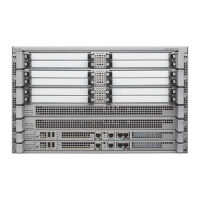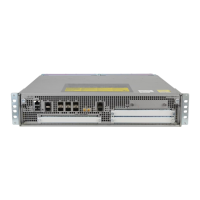To configure the minimum bandwidth service for the SIP and distribute the excess weight to the low priority
packets on the per ESI link per CC, execute the hw-module slot slot-number qos input link link-index
{bandwidth value | weight weight} command from the Global configuration mode.
Behavioral Changes in Scheduling
In Cisco IOS XE Release 6.0 and earlier images, by default, the SIP-10 scheduler and the ESP scheduler ran
in port-fairness and ESP-fairness mode where each buffer is scheduled at a rate proportional to its interface
bandwidth. As a result, even high-priority packets were treated based on a rate that was proportional to its
interface bandwidth. In Cisco IOS XE Release 3.1S, the SIP-10 scheduler, SIP-40 scheduler, and ESP scheduler
ran in strict-priority mode. In this mode, if the high-priority queues of either a participating SPA port or a
participating SIP has data to send, these queues will be scheduled first. The remaining bandwidth, if any, will
then be shared among the low-priority buffers at a weight that is proportional to the interface bandwidth or
at a weight that is equal to the weight of all the SIPs.
The supported excess weight range from Cisco IOS XE Release 3.1S and onwards for intra-SIP scheduling
is as follows:
• SIP-10— 40 to 10000
• SIP-40— 40 to 10000
The supported minimum bandwidth range from Cisco IOS XE Release 3.1S and onwards for Inter-SIP
scheduling depends on the combination of SIP and ESP. The following is the range for minimum bandwidth
configuration for various combination of SIP and ESP:
•
SIP-10 with all ESP: 1 Mbps to 11.2 Gbps
•
SIP-40 with ESP10/ESP20: 1 Mbps to 11.2 Gbps
•
SIP-40 with ESP40: 1Mbps to 23 Gbps on each ESI link
•
SIP-40 with ESP100: Up to 100 Gbps
The supported excess weight range for inter carrier card scheduling (ESP level) is as follows:
• All ESPs— 50 to 100
Configuring Intra-CC Scheduling
By default, ingress packets that are classified as high-priority by a SIP or SPA, are processed first, and then
sent. After processing the high-priority packets, the available excess bandwidth can be shared by low-priority
packets depending on the weight assigned to the interface or to the SPA. Execute the following commands
to configure the weight on an interface or for the entire SPA:
Cisco ASR 1000 Series Aggregation Services Routers SIP and SPA Software Configuration Guide, Cisco IOS XE
Everest 16.5
OL-14127-17 449
Classifying and Scheduling Packets for the ASR 1000 Series Aggregation Services Routers
Scheduling Overview

